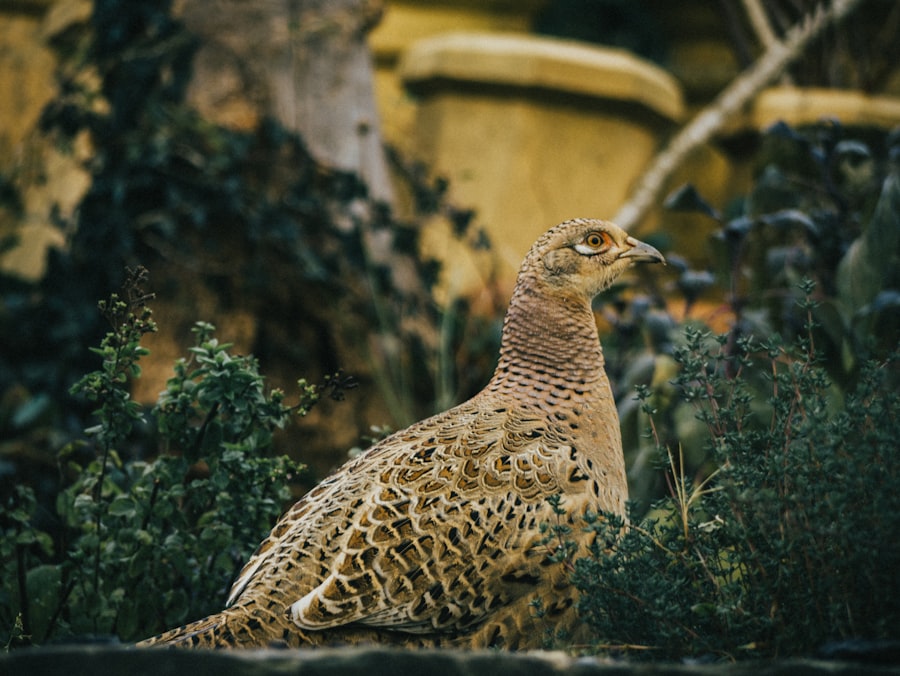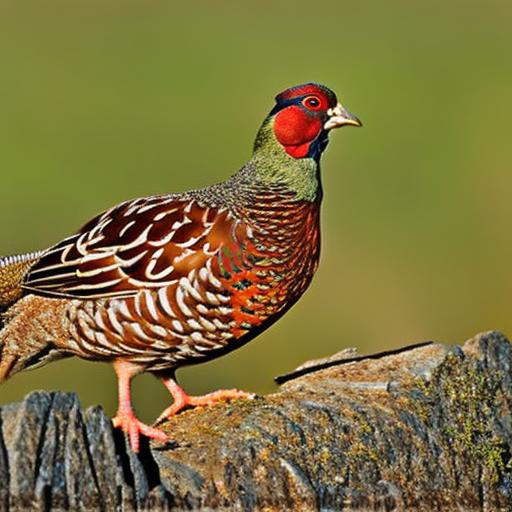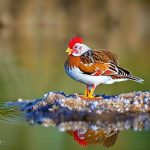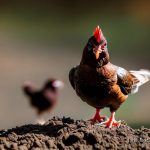Have you ever wondered if pheasants and chickens can live together in the same coop? Well, wonder no more! In this blog post, we’ll explore the possibility of keeping these two birds together and what you need to know before making the decision.
Pheasants and chickens are both popular birds to keep on a farm or in a backyard coop. They provide eggs, meat, and can be enjoyable to watch. However, there are some important factors to consider before deciding to keep them together. Pheasants and chickens may look similar, but they have some distinct differences in behavior, dietary needs, and space requirements.
Key Takeaways
- Pheasants and chickens can coexist in a chicken coop, but it requires careful planning and consideration.
- Pheasants and chickens have different needs and behaviors, so it’s important to understand their differences before keeping them together.
- Advantages of keeping pheasants and chickens together include pest control and increased diversity, while disadvantages include potential aggression and disease transmission.
- Factors to consider before keeping pheasants and chickens together include space, climate, and compatibility.
- To prepare a chicken coop for pheasants, it’s important to provide adequate space, nesting areas, and perches, as well as secure fencing and protection from predators.
Understanding the Differences Between Pheasants and Chickens
Pheasants and chickens may look similar at first glance, but they have some key differences that need to be understood before considering keeping them together in a coop. Pheasants are wild birds that have been domesticated for farming purposes. They have different behaviors and dietary needs compared to chickens.
Pheasants are more flighty and skittish than chickens. They are known for their ability to fly long distances and prefer open spaces. Chickens, on the other hand, are more docile and tend to stay close to the ground. This difference in behavior can cause stress for both birds if they are kept together in a confined space.
In terms of dietary needs, pheasants require a higher protein diet compared to chickens. They are omnivorous birds that eat insects, seeds, grains, and vegetation. Chickens, on the other hand, are primarily herbivorous and eat grains, seeds, fruits, and vegetables. It is important to provide a balanced diet for both birds if they are kept together.
Advantages and Disadvantages of Keeping Pheasants and Chickens Together
There are both advantages and disadvantages to keeping pheasants and chickens together in the same coop. One advantage is that pheasants can help control pests in the coop. They are natural foragers and will eat insects and other pests that may be present. This can help reduce the need for chemical pest control methods.
Another advantage is that pheasants can provide additional income or food sources. Pheasant meat is considered a delicacy in some cultures and can be sold for a higher price compared to chicken meat. Pheasant eggs can also be collected and sold or used for personal consumption.
However, there are also disadvantages to keeping pheasants and chickens together. Pheasants are more prone to disease compared to chickens. They have weaker immune systems and can easily contract diseases from other birds. This can pose a risk to the health of both the pheasants and the chickens.
Additionally, pheasants require more space compared to chickens. They are larger birds and need more room to move around and fly. If they are kept in a small coop with chickens, they may become stressed and exhibit aggressive behavior.
Factors to Consider Before Keeping Pheasants and Chickens Together
Before making the decision to keep pheasants and chickens together, there are several factors to consider. These include the size of your coop, the temperament of your birds, and the climate in your area.
The size of your coop is an important factor to consider when keeping pheasants and chickens together. Pheasants require more space compared to chickens, so you will need a larger coop or run to accommodate them. Ideally, each bird should have at least 4 square feet of space in the coop.
The temperament of your birds is another important factor to consider. Some chickens may be more aggressive towards pheasants, especially if they are introduced to the coop at a later stage. It is important to observe the behavior of your birds and ensure that they are compatible before keeping them together.
The climate in your area is also an important consideration. Pheasants are more cold-hardy compared to chickens and can tolerate colder temperatures. However, they may not do well in extremely hot climates. It is important to provide adequate ventilation and shade in the coop to ensure the comfort of both the pheasants and the chickens.
Preparing Your Chicken Coop for Pheasants
If you’ve decided to keep pheasants and chickens together, you’ll need to make some adjustments to your coop. This may include adding perches and nesting boxes for the pheasants, as well as providing adequate ventilation.
Pheasants are more flighty compared to chickens and prefer to roost on perches rather than on the ground. It is important to provide perches at different heights in the coop to accommodate the pheasants’ natural behavior. This will also help reduce stress and aggression between the birds.
Nesting boxes are also important for pheasants. They prefer to lay their eggs in secluded areas, so providing nesting boxes will help encourage them to lay eggs in a designated area. The nesting boxes should be large enough to accommodate the size of the pheasants and should be filled with straw or other suitable nesting material.
Adequate ventilation is crucial when keeping pheasants and chickens together. Pheasants are more prone to respiratory diseases compared to chickens, so it is important to provide good air circulation in the coop. This can be achieved by adding windows or vents that can be opened or closed depending on the weather conditions.
Chicken Coop Plan for Keeping Pheasants and Chickens Together

To ensure that your pheasants and chickens are happy and healthy in the same coop, you’ll need to have a plan in place. This may include separating the birds during feeding time and providing separate areas for dust bathing.
Pheasants and chickens have different dietary needs, so it is important to provide separate feeders for each bird. This will ensure that each bird is getting the appropriate nutrition without competition or aggression. It is also important to monitor the feed consumption of each bird to ensure that they are eating enough.
Dust bathing is an important behavior for both pheasants and chickens. It helps keep their feathers clean and free from parasites. However, pheasants and chickens may prefer different areas for dust bathing. It is important to provide separate areas for each bird to engage in this behavior without competition or aggression.
Providing Adequate Space for Pheasants and Chickens in the Coop
One of the most important factors in keeping pheasants and chickens together is providing enough space in the coop. Pheasants are larger than chickens and need more room to move around. Ideally, each bird should have at least 4 square feet of space in the coop.
If you have a small coop, it may be necessary to provide a separate area or run for the pheasants. This will help reduce stress and aggression between the birds and ensure that they have enough space to move around comfortably.
It is also important to provide enough roosting space for both pheasants and chickens. Pheasants prefer to roost on perches, so it is important to provide enough perches at different heights in the coop. Chickens, on the other hand, prefer to roost on the ground or on low perches. Providing a variety of roosting options will help accommodate the natural behaviors of both birds.
Feeding and Watering Pheasants and Chickens in the Same Coop
Feeding and watering pheasants and chickens in the same coop can be a challenge. Pheasants have different dietary needs than chickens and may require separate feeders and waterers.
Pheasants require a higher protein diet compared to chickens. They need a feed that is specifically formulated for game birds or pheasants. It is important to provide separate feeders for each bird to ensure that they are getting the appropriate nutrition without competition or aggression.
Watering can also be a challenge when keeping pheasants and chickens together. Pheasants prefer shallow water sources, while chickens are more comfortable with deeper water sources. It is important to provide separate waterers for each bird to accommodate their preferences.
Maintaining Hygiene and Health in the Coop
Keeping your coop clean and healthy is essential when keeping pheasants and chickens together. This may include regular cleaning and disinfecting, as well as monitoring your birds for signs of illness.
Pheasants are more prone to respiratory diseases compared to chickens, so it is important to provide good ventilation in the coop. This will help reduce the risk of respiratory infections. Regular cleaning and disinfecting of the coop will also help reduce the risk of disease transmission between the birds.
It is important to monitor your birds for signs of illness, such as coughing, sneezing, or lethargy. If you notice any signs of illness, it is important to isolate the affected bird and seek veterinary care if necessary. Prompt treatment can help prevent the spread of disease to other birds in the coop.
Is Keeping Pheasants with Chickens Right for You?
Keeping pheasants and chickens together can be a rewarding experience, but it’s not for everyone. Before making the decision, be sure to consider all the factors and make a plan for keeping your birds happy and healthy.
If you have the space, resources, and knowledge to accommodate the different needs of pheasants and chickens, keeping them together can be a great way to maximize the benefits of both birds. However, if you are unsure or do not have the necessary resources, it may be best to keep them separate.
Remember to always prioritize the health and well-being of your birds. Regular monitoring, proper nutrition, and good hygiene practices are essential for keeping pheasants and chickens together successfully. With careful planning and consideration, you can create a coop environment that is suitable for both birds and enjoy the benefits they bring.
If you’re wondering whether you can keep pheasants with chickens, you may also be interested in learning about the compatibility of guinea fowl and chickens. Poultry Wizard has a helpful article on their website that explores the topic of whether guinea fowl can live with chickens. To find out more, check out their article here.
FAQs
What are pheasants?
Pheasants are a type of game bird that are often kept for their meat or for hunting purposes. They are native to Asia but have been introduced to other parts of the world, including North America.
Can pheasants be kept with chickens?
It is possible to keep pheasants with chickens, but it is not recommended. Pheasants have different dietary and environmental needs than chickens, and they may not get along well together. Additionally, pheasants can carry diseases that can be harmful to chickens.
What are the differences between pheasants and chickens?
Pheasants are generally larger and more colorful than chickens. They also have different dietary needs and require different types of housing and environmental conditions.
What should I consider before keeping pheasants with chickens?
Before keeping pheasants with chickens, you should consider the space and housing requirements for both types of birds. You should also consider their dietary needs and whether they will get along well together. It is also important to be aware of any potential health risks associated with keeping different types of birds together.
What are some potential problems with keeping pheasants and chickens together?
Some potential problems with keeping pheasants and chickens together include fighting between the birds, differences in dietary needs, and the risk of disease transmission. Additionally, pheasants may require different types of housing and environmental conditions than chickens.
Meet Walter, the feathered-friend fanatic of Florida! Nestled in the sunshine state, Walter struts through life with his feathered companions, clucking his way to happiness. With a coop that’s fancier than a five-star hotel, he’s the Don Juan of the chicken world. When he’s not teaching his hens to do the cha-cha, you’ll find him in a heated debate with his prized rooster, Sir Clucks-a-Lot. Walter’s poultry passion is no yolk; he’s the sunny-side-up guy you never knew you needed in your flock of friends!







